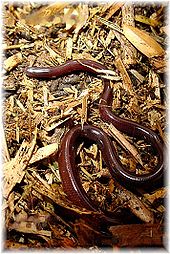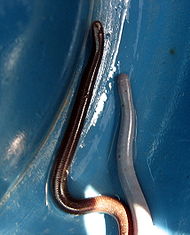- Ramphotyphlops braminus
-
Ramphotyphlops braminus 
Conservation status Scientific classification Kingdom: Animalia Phylum: Chordata Subphylum: Vertebrata Class: Reptilia Order: Squamata Suborder: Serpentes Family: Typhlopidae Genus: Ramphotyphlops Species: R. braminus Binomial name Ramphotyphlops braminus
(Daudin, 1803)Synonyms - Eryx braminus - Daudin, 1803
- [Tortrix] Russelii - Merrem, 1820
- Typhlops braminus - Cuvier, 1829
- Typhlops Russeli - Schlegel, 1839
- Argyrophis truncatus - Gray, 1845
- Argyrophis Bramicus - Gray, 1845
- Eryx Bramicus - Gray, 1845
- Tortrix Bramicus - Gray, 1845
- Onychocephalus Capensis - A. Smith, 1946
- Ophthalmidium tenue - Hallowell, 1861
- T[yphlops]. (Typhlops) inconspicuus - Jan, 1863
- T[yphlops]. (Typhlops) accedens - Jan, 1863
- T[yphlops]. accedens - Jan & Sordelli, 1864
- Typhlops (Typhlops) euproctus - Boettger, 1882
- Typhlops bramineus - Meyer, 1887
- Tortrix russellii - Boulenger, 1893
- Typhlops russellii - Boulenger, 1893
- Typhlops braminus - Boulenger, 1893
- Typhlops accedens - Boulenger, 1893
- Typhlops limbrickii - Annandale, 1906
- Typhlops braminus var. arenicola - Annandale, 1906
- [Typhlops braminus] var. pallidus - Wall, 1909
- Typhlops microcephalus - Werner, 1909
- Glauconia braueri - Sternfeld, 1910
- [Typhlops] braueri - Boulenger, 1910
- Typhlopidae braminus - Roux, 1911
- Typhlops fletcheri - Wall, 1919
- Typhlops braminus braminus - Mertens, 1930
- Typhlops braminus - Nakamura, 1938
- Typhlops pseudosaurus - Dryden & Taylor, 1969
- Typhlina (?) bramina - McDowell, 1974
- Ramphotyphlops braminus - Nussbaum, 1980[1]
Ramphotyphlops braminus is a harmless blind snake species found mostly in Africa and Asia, but has been introduced in many other parts of the world. Completely fossorial, they are often mistaken for earthworms, except that they are not segmented. The specific name is a Latinized form of the word Brahmin, which is a caste among Hindus. No subspecies are currently recognized.[2]
Contents
Description
Adults are small and thin, averaging between 6.35-16.5 cm (2½ to 6½ inches) in length. The head and tail-tip look much the same, with no narrowing of the neck. The rudimentary eyes appear only as a pair of small dots under the head scales. The tip of the tail ends with a tiny pointed spur. The head scales are small and resemble those on the body. There are 14 rows of dorsal scales along the entire body. The coloration of the adults varies from shiny silver gray to charcoal gray or purple. The venter is grayish to brown. Juveniles are colored much the same as the adults.[3]
The tiny eyes are covered with translucent scales, rendering these snakes almost entirely blind. The eyes cannot form images, but are still capable of registering light intensity.
Common names
Ramphotyphlops braminus is variously known as Brahminy blind snake (or Brahminy blindsnake),[2] flowerpot snake, common blind snake, island blind snake, Hawaiian blind snake, Nilgiri worm snake (for the synonym Typhlops fletcheri), and Perrotet's shieldtail snake (for the synonym Typhlina bramina). The moniker flowerpot snake derives from the snake's incidental introduction to various parts of the world through the plant trade.
Geographic range
Found in Africa and Asia, but being an introduced species in many parts of the world, it is also found in Australia and the Americas. It is common throughout most of Florida [1]
In Africa, it has been reported in Benin, Togo, Ivory Coast, Cameroon, Somalia, Zanzibar, coastal Tanzania, Mozambique, South Africa (an isolated colony in Cape Town), Madagascar, the Comoro Islands, Mauritius, the Mascarene Islands and the Seychelles.
In Asia it occurs in Arabia, Iran, Pakistan, Nepal, mainland India, the Maldives, the Lakshadweep Islands, Sri Lanka, Bangladesh, the Andaman Islands, the Nicobar Islands, Myanmar, Thailand, Laos, Cambodia, Vietnam, the Ryukyu Islands of Okinawashima and Miyakoshima, Taiwan, Hong Kong, southern China, Hainan, the Malay Peninsula, the Maritime Southeast Asia including Singapore, Sumatra and nearby islands (the Riao Archipelago, Bangka, Billiton and Nias), Borneo, Sulawesi, the Philippines, Butung, Salajar, Ternate, Halmahera, Buru, Ceram, Ambon, Saparua, Java, Bali, Lombok, Sumbawa, Madura, Flores, Lomblen, Sumba, Timor, Kai Island, the Aru Islands (requires confirmation according to McDowell, 1974:25), New Guinea (Irian Jaya and Papua New Guinea), New Britain and Bougainville Island. In Australia in the Northern Territory near Darwin and the northern tip of Queensland). It occurs in the Cocos (Keeling) Islands, on Christmas Island, Palau, Guam, Saipan and the Hawaiian Islands. The Americas in the United States (California, Massachusetts, and Florida), western and southern Mexico and Guatemala and in the Cayman Islands. The vertical distribution is from sea level to 1,200 m in Sri Lanka and up to 1,500 m in Gautemala. The type locality given is "Vizagapatam" [India].[1]
This is also the only snake reported from Lakshadweep Islands.[4]
Habitat
Usually occur in urban and agricultural areas.[3] These snakes live underground in ant and termite nests. They are also found under logs, moist leaves and humus in wet forest, dry jungle and even city gardens. The distribution and survival of this group of snakes directly reflects soil humidity and temperature.[4]
Feeding
Their diet consists of the larvae, eggs, and pupae of ants and termites.[3]
Reproduction
This species is parthenogenetic and all specimens collected so far have been female. They lay eggs or may bear live young. Up to eight offspring are produced: all female and all genetically identical.[3]
References
- ^ a b McDiarmid RW, Campbell JA, Touré T. 1999. Snake Species of the World: A Taxonomic and Geographic Reference, vol. 1. Herpetologists' League. 511 pp. ISBN 1-893777-00-6 (series). ISBN 1-893777-01-4 (volume).
- ^ a b c "Ramphotyphlops braminus". Integrated Taxonomic Information System. http://www.itis.gov/servlet/SingleRpt/SingleRpt?search_topic=TSN&search_value=174341. Retrieved 30 August 2007.
- ^ a b c d Brahminy Blind Snake at the Florida State Museum of Natural History. Accessed 30 August 2007.
- ^ a b Whitaker R. 1978. Common Indian Snakes: A Field Guide. Macmillan India Limited.
Further reading
- Annandale, N. 1906. Notes on the fauna of a desert tract in southern India. Part. I. Batrachians and reptiles, with remarks on the reptiles of the desert region of the North-West Frontier. Mem. Asiatic Soc. Bengal, Calcutta 1: 183-202.
- Boulenger GA. 1893. Catalogue of the snakes in the British Museum (Nat. Hist.) I. London (Taylor & Francis), 448 pp.
- Daudin FM. 1802. Histoire Naturelle, Générale et Particulière des Reptiles. vol. 7. Paris: Dufart, 436 pp.
- Jones GS, Thomas LA, Wong K. 1995. Ramphotyphlops braminus. Herpetological Review, 26 (4):210-211.
- Kelaart EF. 1854. Catalogue of reptiles collected in Ceylon. Ann. Mag. Nat. Hist. (2) 13: 137-140.
- Kraus F, Cravalho D. 2001. The Risk to Hawai'i from Snakes. Pacific Science, Vol. 55, no. 4:409-417. PDF at University of Hawai'i press. Accessed 20 April 2008.
- Nussbaum, RA. 1980. The brahminy blind snake (Ramphotyphlops braminus) in the Seychelles Archipelago: Distribution, variation, and further evidence for parthenogenesis. Herpetologica 36 (3): 215-221.
- Oliver JA, Shaw CE. 1953. The amphibians and reptiles of the Hawaiian Islands. New York. Zoologica, Vol. 38, no. 5: 65-95.
- O'Shea M, Halliday T. 2002. Smithsonian Handbooks: Reptiles and Amphibians. DK Publishing. 256 pp. ISBN 0789493934.
- Ota H, Hikida T, Matsui M, Mori A, Wynn AH. 1991. Morphological variation, karyotype and reproduction of the parthenogenetic blind snake, Ramphotyphlops braminus, from the insular region of East Asia and Saipan. Amphibia-Reptilia 12: 181-193
- Owen, R, Bowman DT Jr, Johnson SA. 1998. Geographic Distribution. Ramphotyphlops braminus. Herpetological Review 29 (2): 115.
- Palmer, DD and RN Fisher. 2010. Geographic Distribution. Ramphotyphlops braminus. Herpetological Review 41(4):518.
- Thomas LA. 1997. Geographic Distribution. Ramphotyphlops braminus. Herpetological Review 28 (2): 98.
- Vijayakumar SP, David P. 2006. Taxonomy, Natural History, And Distribution Of The Snakes Of The Nicobar Islands (INDIA), Based On New Materials And With An Emphasis On Endemic Species. Russian Journal of Herpetology Vol. 13, No. 1, 2006, pp. 11 – 40.
- Wall F. 1919. Notes on a collection of Snakes made in the Nilgiri Hills and the adjacent Wynaad. J. Bombay Nat. Hist. Soc. 26: 552-584.
- Wallach V. 1999. Geographic distribution: Ramphotyphlops braminus. Herpetological Review 30 (4): 236.
- Wynn AH, Cole CJ, Gardner AL. 1987. Apparent Triploidy in the Unisexual Brahminy Blind Snake, Ramphotyphlops braminus. Am. Mus. Novit. 2868: 1-7.
- Russell, from [Journal of the Asiatic Society of Bengal, Volume 16, Part 2] at [2]. Accessed 7 Nov 2009.
External links
- Ramphotyphlops braminus at the Reptarium.cz Reptile Database. Accessed 30 August 2007.
- Image of Ramphotyphlops braminus at the Institute of Toxicology and Genetics. Accessed 30 August 2007.
- Ramphotyphlops braminus at Snakes of Japan. Accessed 30 August 2007.
- Ramphotyphlops braminus at WildHerps.com. Accessed 30 August 2007.
Categories:- IUCN Red List least concern species
- Typhlopidae
- Reptiles of Asia
- Reptiles of Pakistan
- Reptiles of Thailand
- Reptiles of Japan
- Reptiles of the Philippines
- Vertebrate parthenogenesis
- Reptiles of India
- Reptiles of Guatemala
- Reptiles of Mexico
- Reptiles of Hawaii
Wikimedia Foundation. 2010.



